- Jewelry
- Crosses
- Rings
- Mens
- Claddagh
- Wedding
- Personalized Jewelry
- John Urban Jewelry
- Sale
- Gift Certificates
- About Us

May 11, 2016 marks the 20th anniversary of the crash of ValueJet flight 592 that killed 110 passengers and crew in the Everglades near Miami International Airport. The chance discovery of a small gold and gemstone pendant in February 2013 involved Walker Metalsmiths in a bizarre and heart wrenching story that was picked up by scores of major news organizations including the Associated Press, Huffington Post, Fox News, ABC, CBS and many more. (Links at the end of this blog)
Believe it or not our part of the story begins with a snake hunt. Three friends didn’t bag any snakes during the 2013 Python Challenge, but they did make a startling find. While searching the Everglades for invasive Burmese Pythons, Mark Rubinstein spotted a jeweled gold cross with antique rose cut diamonds and sapphires set in high carat gold. The condition of the piece and the location of the find strongly suggest that the antique medallion came to rest in the swamp from as the result of a fatal plane crash. Rubinstein soon. shifted gears in his quest from looking for serpents to trying to locate a surviving relative he can return the jewel to.
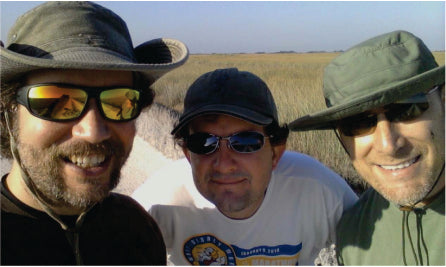
The python hunters, Joe Post, Gregg Jobes and Mark Rubinstein.
The find was made in an area that turns out to have been about 300 yards east of the ValuJet crash site (May 11 1996) and in the debris field area of the Eastern Flight 401 (December 29 1972). Both of these tragedies were horrific. An edge of the circular medallion is melted, which would be more consistent with ValueJet crash. The object is a circular medallion the size of a penny that was most probably meant to be worn as a pendant. This is uncertain since the loop or bail that it might have been used to attach it to a chain is apparently melted into a glob of metal.
To begin his search for the owner, Rubinstein contacted Sziro Jewelry in Coral Springs. They confirmed that the piece is indeed gold and that the eight diamonds are “rose cut”, a style of polishing that was common in the 17th to 19th centuries. The design would indicate that there were originally thirteen sapphires arranged in a cross pattern. Donald Dietz of the Florida Goldcoast Gem and Mineral Society then posted photos of the piece were on a prominent jeweler’s online forum, which brought it to our attention.
A cross within a circle is often recognized as a “Celtic” cross. As a Celtic jeweler, I noted that the diamond studded boarder looks very much like the Celtic Tree of Life symbol, but the overall style and design was not consistent with any Celtic jewelers known to me. The style might just as likely be Byzantine. Apparent symbols between the arms of the cross suggest abstract versions of Greek letters, but nothing obvious. I also noted that many pieces of modern Celtic jewelry are deliberately made to have an antique look, so the older style of stone cutting could possibly have been chosen by a more recent jeweler to give the piece an antique look.
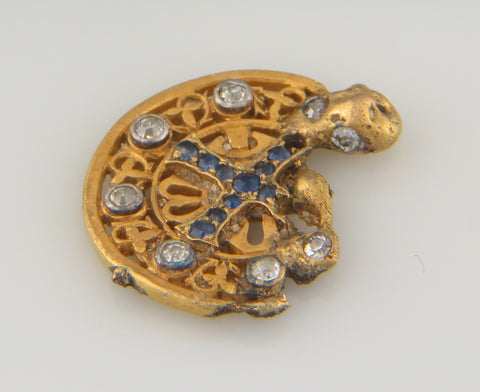
Realizing what an interesting story this was, combining giant snakes, mysterious found treasure and horrific disaster, It seemed to me that the best way to help Mark find the owner would be to write a news release and present the story to the media, with the hope that someone with knowledge of the loss would know whose jewelry this was. Soon after the story was posted on PRWeb we began getting calls for interviews from the AP, Good Morning America, CBS News and a number of newspapers and other news outlets. Mark then sent me the pendant so that I could examine and analyze it.
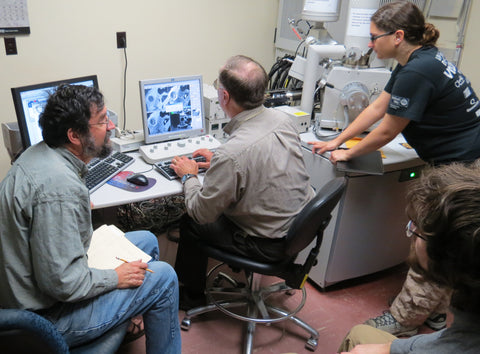
Scientific testing of the pendant at Alfred University
I had the piece tested at the material sciences lab at Alfred University in Alfred, NY. Metallurgist Gerry Wynick ran tests with the University’s energy dispersive spectroscopy equipment. The results are that the pendant is 20 karat gold, alloyed with silver and copper. The eight rose cut diamonds are set in platinum bezels. The materials and style suggest that the handmade piece was created between 1880 and 1918.
Dark areas on the melted back of the pendant show that other materials stuck to the semi-molten gold while it was hot. Significantly, titanium is present, which is used extensively in aircraft. Also present in the contaminated area is chromium, iron, calcium and phosphorus. Since the ValuJet crash was a result of a fire, this is strong evidence that the piece is from that disaster.
Symbolic meaning of the pendant
The meaning of the seemingly Greek or Russian letters in the quadrants has been debated and pondered by those investigating the mystery since it first came to light. One letter appeared to be the Greek character phi. This lead to speculation about there being an Eastern Orthodox origin for the piece, rather than it being a Celtic cross. The phi is actually the letters "O" and "I" superimposed in the same space. This was revealed by a man, who prefers to remain anonymous, that saw the pendant in a story in the Saturday June 8 Miami Herald sent the following photo and story by e-mail:
Similar pendant from Cuba
"Some 40 years ago, as a young teen, my mother one day presented me with a very special pendant (please see attached photos). It had been given to her by my father, on the evening which they formally announced their engagement; that was in Cuba, at a party hosted by my great-grandmother in 1945. As the story goes, circa 1900 (on a similar evening and occasion),the pendant was presented by my paternal grandfather to my grandmother, and so on and so forth leading back several generations of my father's family. I believe the one given to me by my mother was a replica of the original, first gifted a few centuries ago by one of my ancestors to his soon-to-be bride.
The pendant found by Mr. Rubinstein, which is pictured alongside Ms. Brecher's article in this morning's The Miami Herald is missing a section which should contains the letter "E". You see, the pendant is composed in such a way as to represent two all-important virtues: God & love. As for God virtue, that obviously is symbolized by the cross; I well understand how the letter "M" may have been interpreted to also have a religious versus romantic connotation… it does not in fact denote the Virgin Mary, but rather, together with the letters etched in the gold work of the other outer quadrants of the cross forms the French "en moi" (e / n / m / oi ), or in English, "in me". The love virtue represented in the pendant is a play on the words: "Crois En Moi" (the French for "cross" in fact being "croix", but pronounced the same), or "believe in me" -- that is, believe in God and believe in love (or more specifically, believe in your future betrothed)."
Despite an amazing amount of publicity the owner of the pendant has not been identified. It is now kept in a safe deposit box in Miami under the stewardship of mark Rubenstein. The mystery of the materials, meaning and tragic circumstances that caused the damage to the pendant have been discovered, however the personal story of the owner remains unknown.
Links to published articles:
CBS Miami UK Daily Mail NBC News Miami Herald USA Today ABC News Associated Press 2016 with video Walker Metalsmiths original news release Fox News Olean Times Herald
Glad to see this story is still alive. However I surprised that you did not include any photos or scans of my pendant that I sent to you that is identical and intact to these except that my stones are ruby and diamond. I found my pendant in an antique store over 40 years ago.
A worthy endeavor.I hope you are successful.Yo cuz.
Comments will be approved before showing up.
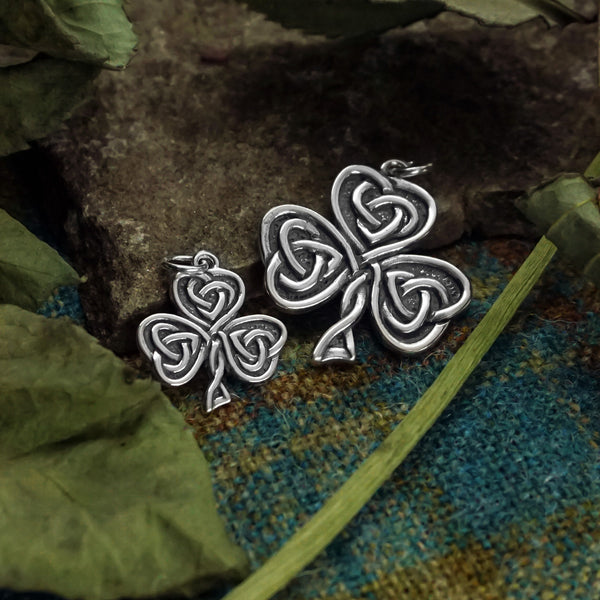

Thousands of photographs were taken. Help find at least one.
Were you a tourist in London, Dublin or Paris in 1975 – 1978? Did you see a street performer playing bagpipes? Did you take his picture? Was it Steve Walker? If you can share that picture with Walker Metalsmiths you could score some sweet Celtic jewelry.
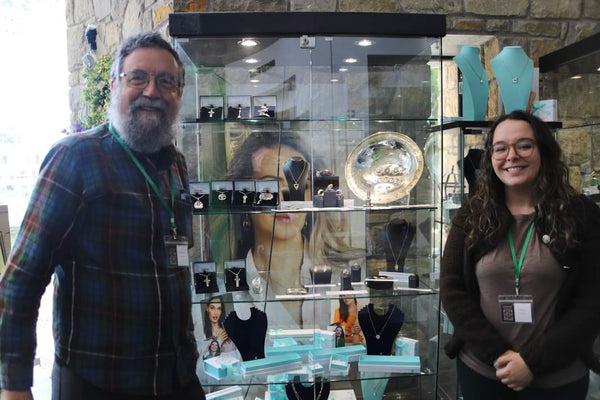
Anna
September 15, 2018
Nothing even vaguely “Celtic” about this—but then, I’m Irish, and am often astounded at how Americans use that word. Also, as a jeweller, you surely know a “border” from a “boarder.”
Anyway, pity that this little mystery is unlikely ever to be resolved.